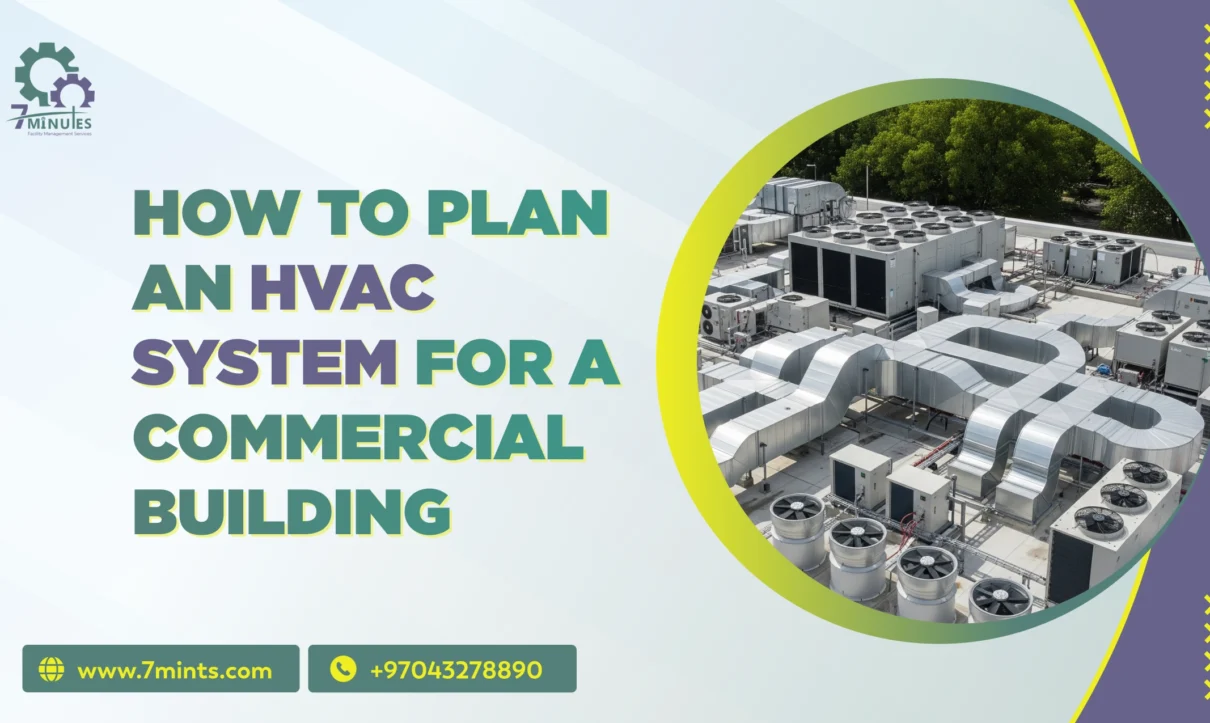A well-planned HVAC (Heating, Ventilation, and Air Conditioning) system is essential for ensuring comfort, indoor air quality, and energy efficiency in commercial spaces. From shopping malls to office towers, hospitals, and warehouses, the HVAC system will suit the peculiarities of the building it has to serve. Without proper planning, enormous energy costs, discomfort, and even total system failure can be incurred. A step-by-step, in-depth approach to the planning of an HVAC system for any commercial building is discussed in this blog.
1. Understand the Building’s Purpose and Requirements
The use and purpose of the building have to be well understood before any selection of equipment or design is undertaken. Different commercial buildings, like hospitals, offices, hotels, or data centers, come with different temperature and air quality needs. For example, a hospital may require higher filtration levels with continuous airflow, while an office space may require zoning of temperatures. Evaluating the uses and occupancy of every space will help set up the HVAC system for the best performance.
2. Carry Out a Detailed Load Calculation
A load calculation determines the amount of heating or cooling needed in each space under given conditions by considering room size, direction of the windows, insulation quality, occupancy level, and so on. This calculation makes sure that the HVAC system is properly sized—neither too strong that it wastes energy nor too weak for people to be satisfied. Manual N is a popular choice among professionals performing commercial load calculations in order to obtain the highest accuracy.
3. Select the Right Type of HVAC System
This will mostly decide whether the HVAC system will actually satisfy the varying comfort needs of the building and, as such, its energy requirements, as well as its layout needs. The types include split systems, rooftop packaged units, VRF systems, and centralized chiller-based systems; efficiency; cost based on the size and use of the building; and complexity of installations, which vary. The choice is a value judgment between initial costs and operational efficiency, as well as maintenance costs in the long run.
4. Design for Zoning and Flexibility
Zoning permits the building to be section-wise, heating or cooling based on individual needs. For example, a meeting room with heavy occupancy requires higher airflow than a hallway or a storage room. Establishing zones improves energy efficiency and occupant comfort by allowing the building to be climate-controlled in a targeted fashion. Also, while designing for flexibility, ensure that the HVAC system will accommodate future changes in the layout or shifts in occupancy.
5. Energy Efficiency Should Be Considered from Day One
Energy-efficient HVAC planning keeps long-term costs and the environmental effect down. Choosing high-efficiency systems and components reduces energy usage-they are mostly variable-speed fans and programmable thermostats. One advantage is that less expensive energy recovery and economizers can be included in their titles. Efficient planning as an initial effort ensures efficient operation of the building into the future.
6. Ductwork and Airflow Should Be Strategically Planned
Ductwork is the main infrastructure of the HVAC system, supplying air to a building. Misapplication of ducts may cause energy losses, noisy operation, and uneven airflow configurations in zones. To prevent such occurrences, ducts are to be sized well, insulated correctly, sealed correctly, and laid out with minimal bends and restrictions. Airflow planning is done so that air is distributed evenly and maximum pressure is never put on the HVAC equipment. Check out our latest blog post on Top 6 Plumbing Maintenance Tips for Commercial Buildings
7. Implement Building Automation and Controls
Think of BAS, or building automation systems, as those systems that bring about an elevation in the management of HVAC systems to be controlled and monitored from a single point. This intelligent system segregates airflow, temperature, and humidity under real-time data regarding usage and occupancy. It further sends alerts for maintenance checks, evaluates energy consumption, and so forth, thus saving a lot of manual efforts. Automation keeps ithe door comfort standard while ensuring energy-saving processes and therefore minimal human error.
8. Allow for Ventilation and Indoor Air Quality (IAQ)
Removing pollutants, odors, and high humidity implies maintenance of indoor air quality. Where fresh air supply and exhaust are provided for in the conditioned space in accordance with or beyond ASHRAE 62.1, it is perhaps the major assurance of the supply of fresh air and exhaust. CO₂ sensors and HEPA filters, as well as UV sterilizers, might be further measures toward maintaining air cleanliness in a hospital or high-traffic environment. Balanced ventilation design for thermal comfort serves the interests of occupant well-being.
9. Comply with Local Codes and Standards
Every commercial HVAC design must conform to the local building codes, energy efficiency requirements, and standards for fire safety. Since codes differ from region to region and by project type, early consultation with the local authority is advisable. Non-adherence to compliance can result in costly redesigns, delays in approvals, or, in extreme cases, legal penalties. Designs that work within the legal framework ensure safety and operational integrity and a short time for exploration.
10. Maintenance and Accessibility
Maintenance and maintenance access determine, in large measure, the long-term performance of any HVAC system. During planning, accessibility to any equipment—such as air handlers, compressors, and filters—that might require inspection or repair at some future point should be guaranteed.
11. Estimate Budget and Lifecycle Costs
Do not only look at the initial base cost. Consider the whole lifecycle cost of the HVAC system, which includes installation, energy use, usual maintenance, repairs, and ultimate replacement. So, a highly energy-efficient system may have greater upfront costs than savings later down the road. Therefore, budgeting well with the long-term ROI in mind offers better financial decisions and value.
12. Involve Experts Early in the Design Process
Engaging HVAC engineers and consultants very early in the architectural planning stage yields better results, as HVAC requirements may be purchased systematically against building layout, ceiling heights, etc., in anticipation of potential clashes between HVAC components and architectural features, reducing revisions and therefore resulting in an efficient system integrated with building design.
Conclusion: Future-Proof Your Commercial HVAC Plan
The planning of a commercial HVAC system is not just a technical thing; it could even be viewed as an investment in a building’s performance and occupant comfort. Suppose you consider the functions of a building versus zoning, versus airflow considerations, and energy-efficient systems versus smart automation. In that case, you must come up with an HVAC system that satisfies not just present but future needs. Proper planning also makes things easier to maintain and cheaper to operate and results in a longer system life.
Additionally, take steps slowly, involve professionals, contact us and consider these planning principles in creating an HVAC system that will stand the test of time, toward which it will be a good investment itself.










1 Comment
Comments are closed.